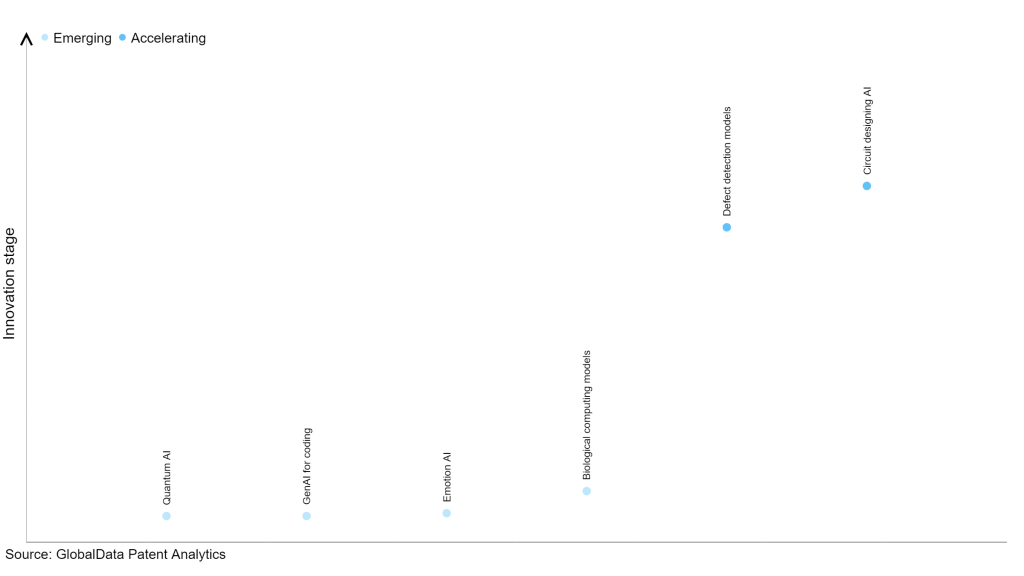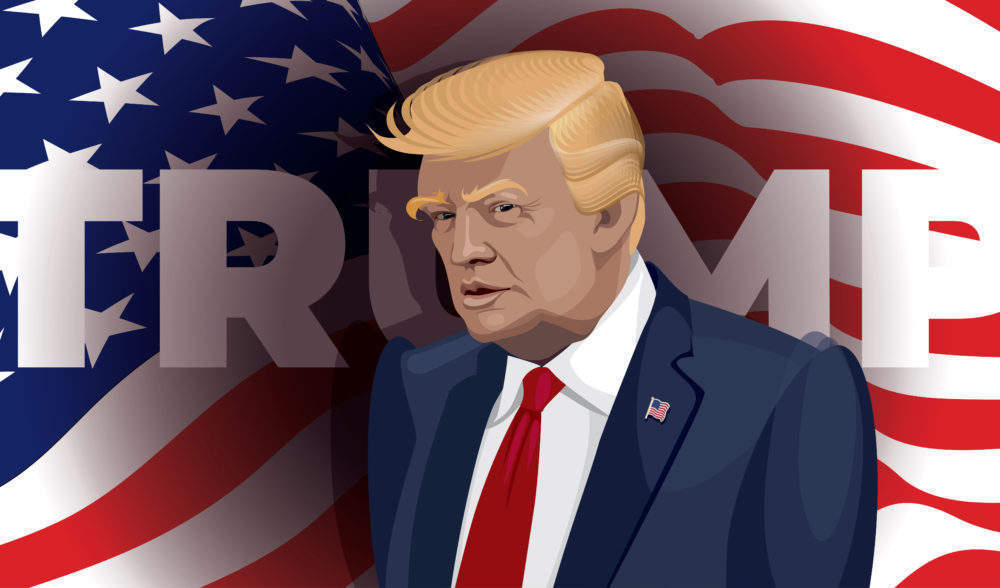The technology industry continues to be a hotbed of patent innovation. Activity is driven by the need for rapid prototyping, customization, and innovative design solutions across various industries, and growing importance of technologies such as generative adversarial networks (GANs) and deep learning to autonomously generate and refine designs, spanning from graphics to industrial products. In the last three years alone, there have been over 1.5 million patents filed and granted in the technology industry, according to GlobalData’s report on Artificial intelligence in technology: GenAI for design. Buy the report here.
However, not all innovations are equal and nor do they follow a constant upward trend. Instead, their evolution takes the form of an S-shaped curve that reflects their typical lifecycle from early emergence to accelerating adoption, before finally stabilizing and reaching maturity.
Identifying where a particular innovation is on this journey, especially those that are in the emerging and accelerating stages, is essential for understanding their current level of adoption and the likely future trajectory and impact they will have.
185+ innovations will shape the technology industry
According to GlobalData’s Technology Foresights, which plots the S-curve for the technology industry using innovation intensity models built on over 1.6 million patents, there are 185+ innovation areas that will shape the future of the industry.
Within the emerging innovation stage, quantum AI, GenAI for coding and emotion AI are disruptive technologies that are in the early stages of application and should be tracked closely. Biological computing models, defect detection models, and circuit designing AI are some of the accelerating innovation areas, where adoption has been steadily increasing.
Innovation S-curve for artificial intelligence in the technology industry

GenAI for design is a key innovation area in artificial intelligence
GenAI for design involves utilizing artificial intelligence (AI) and machine learning (ML) algorithms to enhance and streamline diverse design procedures. This encompasses employing AI methodologies such as deep learning and reinforcement learning to assess and create design frameworks, arrangements, and specifications. Through the utilization of these sophisticated algorithms, GenAI for design endeavors to elevate the productivity, precision, and overall performance of design activities across different fields.
GlobalData’s analysis also uncovers the companies at the forefront of each innovation area and assesses the potential reach and impact of their patenting activity across different applications and geographies. According to GlobalData, there are 2,585+ companies, spanning technology vendors, established technology companies, and up-and-coming start-ups engaged in the development and application of GenAI for design.
Key players in GenAI for design – a disruptive innovation in the technology industry
‘Application diversity’ measures the number of applications identified for each patent. It broadly splits companies into either ‘niche’ or ‘diversified’ innovators.
‘Geographic reach’ refers to the number of countries each patent is registered in. It reflects the breadth of geographic application intended, ranging from ‘global’ to ‘local’.
Patent volumes related to GenAI for design
| Company | Total patents (2010 - 2022) | Premium intelligence on the world's largest companies |
| Tencent Technology (Shenzhen) | 7 | Unlock Company Profile |
| Lam Research | 11 | Unlock Company Profile |
| Schlumberger Technology | 9 | Unlock Company Profile |
| Landmark Graphics | 26 | Unlock Company Profile |
| Samsung Electronics | 28 | Unlock Company Profile |
| Robert Bosch | 5 | Unlock Company Profile |
| ASML Netherlands | 24 | Unlock Company Profile |
| Doosan Enerbility | 5 | Unlock Company Profile |
| Semiconductor Components Industries | 8 | Unlock Company Profile |
| Huawei Technologies | 4 | Unlock Company Profile |
| Schlumberger Canada | 6 | Unlock Company Profile |
| State Grid Zhejiang Electric Power | 6 | Unlock Company Profile |
| State Grid Tianjin Electric Power | 8 | Unlock Company Profile |
| 17 | Unlock Company Profile | |
| Guangdong Power Grid | 5 | Unlock Company Profile |
| Microsoft Technology Licensing | 4 | Unlock Company Profile |
| Stmicroelectronics International | 9 | Unlock Company Profile |
| Bull | 7 | Unlock Company Profile |
| Valmet Automation | 4 | Unlock Company Profile |
| Cadence Design Systems | 13 | Unlock Company Profile |
| Services Petroliers Schlumberger | 6 | Unlock Company Profile |
| TCL Technology Group | 4 | Unlock Company Profile |
| Rolls-Royce | 4 | Unlock Company Profile |
| Qualcomm | 8 | Unlock Company Profile |
| Fanuc | 7 | Unlock Company Profile |
| Texas Instruments | 14 | Unlock Company Profile |
| Lam Research | 13 | Unlock Company Profile |
| Siemens | 9 | Unlock Company Profile |
| Synopsys | 10 | Unlock Company Profile |
| Chiyoda | 5 | Unlock Company Profile |
| Taiwan Semiconductor Manufacturing | 78 | Unlock Company Profile |
| State Grid Corporation of China | 73 | Unlock Company Profile |
| Cetc Potevio Science and Technology | 4 | Unlock Company Profile |
| General Electric | 4 | Unlock Company Profile |
| China Southern Power Grid | 16 | Unlock Company Profile |
| China Petrochemical | 8 | Unlock Company Profile |
| Saudi Arabian Oil | 8 | Unlock Company Profile |
| NVIDIA | 6 | Unlock Company Profile |
| IBM | 29 | Unlock Company Profile |
| STMicroelectronics | 21 | Unlock Company Profile |
| Commonwealth Scientific and Industrial Research Organisation | 5 | Unlock Company Profile |
| Intel | 76 | Unlock Company Profile |
| Global Foundries | 11 | Unlock Company Profile |
| D2S | 6 | Unlock Company Profile |
| InstaDeep | 8 | Unlock Company Profile |
| Chevron U. S. A | 8 | Unlock Company Profile |
| Passivelogic | 8 | Unlock Company Profile |
| BeamUP | 15 | Unlock Company Profile |
| Jiangsu University | 12 | Unlock Company Profile |
| Fuzhou University | 10 | Unlock Company Profile |
Source: GlobalData Patent Analytics
Among the companies innovating in GenAI for design, Taiwan Semiconductor Manufacturing is one of the leading patents filers. The company’s patents are aimed at disclosure that presents a technique and a system to assess the equivalence of the DRM dataset and the DRC dataset. The system acquires both datasets, converting them into a primary and secondary data structure node. It then evaluates whether these nodes align with each other based on a prescribed data structure node comparison model. The other prominent patent filers in the space include State Grid Corporation of China and Intel.
In terms of application diversity, Commonwealth Scientific and Industrial Research Organization leads the pack, while Intel and State Grid Corporation of China stood in the second and third positions, respectively. By means of geographical reach, Intel held the top position, followed by BeamUP and Texas Instruments.
GenAI for design holds substantial significance in revolutionizing the creative and technical aspects of design processes. By leveraging advanced artificial intelligence (AI) algorithms, it has the potential to automate and optimize design tasks across various industries, ranging from graphics to industrial products. The technology enhances efficiency, accuracy, and innovation in design, enabling professionals to create more sophisticated and tailored solutions, while also accelerating the overall design lifecycle. Additionally, GenAI for design opens new possibilities by generating novel design concepts, ultimately pushing the boundaries of what is achievable in the realm of design.
To further understand the key themes and technologies disrupting the technology industry, access GlobalData’s latest thematic research report on Artificial Intelligence (AI).
Data Insights
From

The gold standard of business intelligence.
Blending expert knowledge with cutting-edge technology, GlobalData’s unrivalled proprietary data will enable you to decode what’s happening in your market. You can make better informed decisions and gain a future-proof advantage over your competitors.







